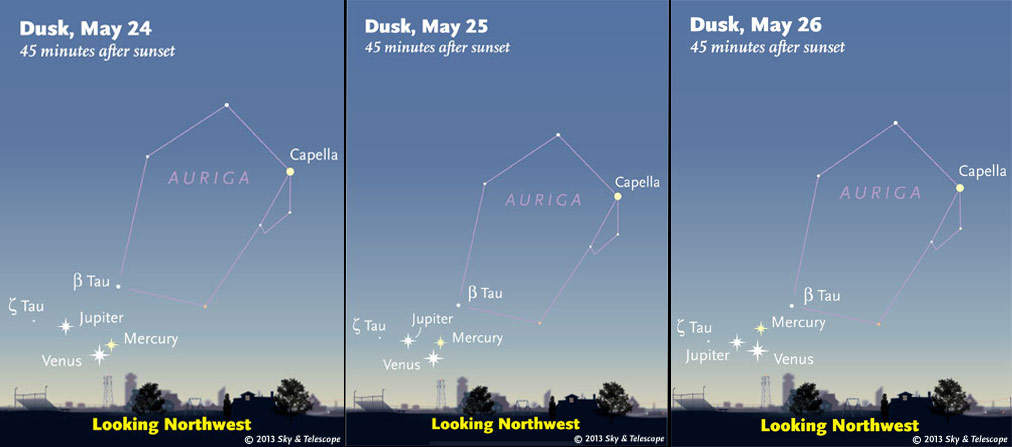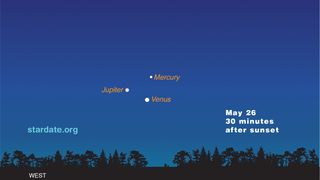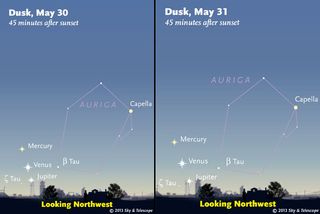
Three planets are coming together in the evening sky at the moment, putting on a celestial show that won't be seen again for more than a decade.
Jupiter, Venus and Mercury are gathering low in the west-northwest evening sky, and next week they'll form the tightest grouping of three naked-eye planets that skywatchers will see until 2026, experts say.
"Here’s a beautiful chance to see three planets all together," Alan MacRobert, a senior editor at Sky & Telescope magazine, said in a statement. "Add the Earth under your feet, and you’re seeing half of the solar system’s planets at once. They’ll be a lovely part of the spring twilight." [Skywatching Events for May 2013]

"The view should be best about 30 to 45 minutes after sunset," MacRobert added. "And think photo opportunity. Set up a camera on a tripod, zoom to the max, and try different time exposures."
Venus and Jupiter are the two brightest planets in the solar system. They've been approaching each other in the evening sky for weeks, and faint Mercury is now joining them, appearing below and to the right of Venus.
By Friday (May 24), all three planets will fit into a circle 5 degrees wide, Sky & Telescope officials said. (Your clenched fist held at arm's length measures about 10 degrees.)
But the trio will draw closer still. By Sunday (May 26), they'll all fit inside a 2.5-degree circle — meaning your thumb held at arm's length will nearly blot them all out.
Get the Space.com Newsletter
Breaking space news, the latest updates on rocket launches, skywatching events and more!
Jupiter and Venus will sit side-by-side Monday evening (May 27), and then the solar system's largest planet will start sliding lower and lower in the sky, disappearing completely in early June.
Meanwhile, Venus will shine brightly as the "Evening Star" for the rest of the year.But as Jupiter falls, Mercury soars, climbing higher and higher above Venus in its best evening apparition of 2013, according to Sky & Telescope. Mercury's rise peaks on June 7, after which it will start sinking back toward the horizon, fading all the while.

Mercury is the solar system's innermost planet. Because of its proximity to the sun, Mercury is rarely in view for more than an hour after sunset or an hour before dawn. The tiny planet can be tough to see, but its current grouping with celestial landmarks Venus and Jupiter should help skywatchers out.
While the three planets appear tightly grouped in our night sky, in reality they're very far away from each other. During the last week of May, Mercury, Venus and Jupiter will be about 105 million miles (169 million kilometers), 150 million miles (241 million km) and 565 million miles (909 million km) away from Earth, respectively, Sky & Telescope officials said.
Late May also offers up another skywatching treat. On Saturday (May 25), viewers with clear skies across much of the Americas and Africa will see a penumbral lunar eclipse, in which the moon darkens as it passes through the outer part of Earth's shadow (known as the penumbra).
Editor's note: If you snap an amazing picture of the three planets or any other night sky view that you'd like to share for a possible story or image gallery, send photos, comments and your name and location to Managing Editor Tariq Malik at spacephotos@space.com.
Follow Mike Wall on Twitter @michaeldwall and Google+. Follow us @Spacedotcom, Facebook or Google+. Originally published on SPACE.com.
Join our Space Forums to keep talking space on the latest missions, night sky and more! And if you have a news tip, correction or comment, let us know at: community@space.com.

Michael Wall is a Senior Space Writer with Space.com and joined the team in 2010. He primarily covers exoplanets, spaceflight and military space, but has been known to dabble in the space art beat. His book about the search for alien life, "Out There," was published on Nov. 13, 2018. Before becoming a science writer, Michael worked as a herpetologist and wildlife biologist. He has a Ph.D. in evolutionary biology from the University of Sydney, Australia, a bachelor's degree from the University of Arizona, and a graduate certificate in science writing from the University of California, Santa Cruz. To find out what his latest project is, you can follow Michael on Twitter.